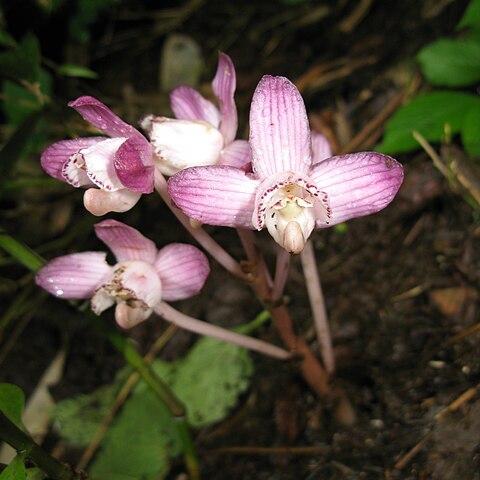Herbs, terrestrial, holomycotrophic. Rhizome cylindric or coralloid, stout, fleshy, branched, with many scalelike sheaths. Stem erect, stout, fleshy, with many scalelike or cucullate sheaths, leafless, pale brown to pinkish white. Inflorescence terminal, racemose, laxly or subdensely few to several flowered; floral bracts often prominent. Flowers purplish rose to yellowish, fleshy; pedicel and ovary elongate. Sepals and petals free, spreading to connivent, ovate. Petals often wider and shorter than sepals; lip oblong, concave, adnate to short column foot at base, spurred at base; disk with a prominent central papillate-pubescent callus; spur broad, protruding forward, parallel to lip, apex obtuse. Column erect, broad, with a fingerlike process projecting on either side of anther at apex, with short column foot at base; anther terminal, incumbent, 2-locular, apex acuminate; pollinia 4, in 2 pairs, granular-farinaceous, sectile, lacking conspicuous caudicles, attached directly to a common viscidium; stigma concave, broad and large; rostellum inconspicuous.
More
Raceme of few to many fls; pedicels short to long; floral bracts scarious. Per. sts glandular-hairy; labellum adaxial in bud but ± twisted away from that position as fl. matures; sepals free, ± similar; petals only slightly smaller, partly covered by dorsal sepal to form hood over column. Labellum as long as petals, erect, broad, concave, ± saccate near broad base, contracted towards tip. Column erect, shorter than labellum; anther erect, pollinia sectile; stigma deeply concave. Plants terrestrial, non-green; rhizome elongated, branched. Flowering stem erect, unbranched, bearing loosely sheathing scales. Obscure genus of few spp. and uncertain limits, recorded from Himalayas, N. Africa, Formosa and Japan.

